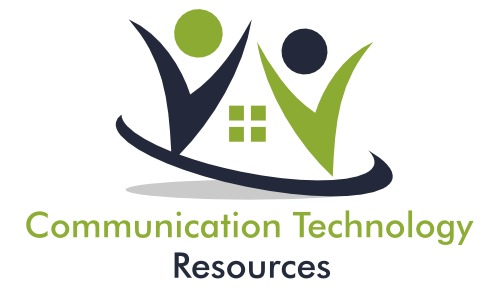School districts and other agencies may contract with CTR to provide full or ½ day workshops, in-services and follow-up trainings. Trainings typically take place at the school location. While COVID restrictions are in place, virtual sessions may be arranged. Below are a sample of possible topics. Other topics may be requested.
AAC and Autism: A Spectrum of Possibilities
This 90-minute session will assist school-based SLP’s in providing effective AAC solutions including use of Tangible Symbol Systems, Picture Exchange (PECS), and iPads with AAC Apps. Key components of an AAC assessment will be reviewed. Two AAC assessment tools will be discussed – the Communication Matrix, designed to evaluate the expressive communication skills of children with severe and multiple disabilities and the Test of Aided-Communication Symbol Performance (TASP), designed to asses four areas of symbolic performance. The benefits of a Tangible Symbol System for students with severe symbolic limitations will be presented. Examples will be provided to demonstrate how these assessments are used to match a student’s abilities to the appropriate AAC App and how several popular AAC Apps lend themselves to supporting IEP goals for (a) syntactic and pragmatic development, (b) classroom participation and (c) demonstrating mastery of core curriculum competencies.
AAC Considerations for Promoting Language Development and Classroom Participation
This 90-minute session begins with a review of normal language development. Aspects of lexical, grammatical and pragmatic acquisition will be highlighted. Participants will re-visit these same developmental milestones with the focus on aided language acquisition. Issues relevant to vocabulary selection and organization will be addressed from a developmental perspective. While understanding development is critical, so too is the ability to assess the receptive and expressive language performance of severely speech impaired individuals. Assessment is needed to benchmark progress and to guide AAC intervention goals and activities. Familiar test measures such as the PPVT, TACL, PLS, and TOLD will be reviewed. They will be discussed in terms of their use with children dependent upon AAC. Procedures for adapting these measures for use by physically impaired children will be presented. Case studies of augmented communicators demonstrating language delays and language disorders will be highlighted. Key topics discussed will include syntactical development, morphological acquisition and the need to use our knowledge of disordered language in speaking children to guide our intervention with users of AAC systems.
Tools and Strategies for Designing an AAC Therapy Camp Program
Camps provide an intensive, creative and motivating venue to improve the communication skills of children using AAC devices. While not all SLPs will have the opportunity to be a part of an AAC camp, all SLPs can develop creative and motivating intervention programs for their students using AAC devices. The first segment of the session addresses administrative aspects of organizing an AAC Camp. Operational considerations (e.g., contracts, insurance, medical forms, and budget) will be highlighted and issues surrounding the program format (i.e., day camp vs. overnight program, family vs camper) will be discussed. The second segment of the session will focus on designing an effective AAC intervention program. This will include a discussion of 3 key intervention components: (a) the need to establish appropriate intervention goals based upon the augmented communicator’s age and language abilities, (b) selecting and organizing a “vocabulary set” appropriately matched to the user’s language abilities and communication goals and (c) Integrating use of the AAC system in functional and meaningful activities.
Gateway©: An Introduction
Gateway© is a series of high-frequency Core Word page sets enabling novel message generation and effective communication at home, school and in the community. It is available as an in-App purchase for Assistiveware’s Proloquo2Go, Snap from Tobii Dynavox, and the TouchChat by Saltillo. Its organization and unique contribute to features making it one of the most efficient AAC Apps available achieving an average of less than1.5 per keystrokes per word. Gateway supports language development for young users and the complex communication needs of linguistically competent teens and adults. This session will begin with an overview of the structure, organization and contents of the Gateway page sets with a special emphasis on Child Functional and the Child Language and Literacy Page Sets. Strategies for customization and implementation will be provided.
AAC and Autism: A Spectrum of Possibilities
This 90-minute session will assist school-based SLP’s in providing effective AAC solutions including use of Tangible Symbol Systems, Picture Exchange (PECS), and iPads with AAC Apps. Key components of an AAC assessment will be reviewed. Two AAC assessment tools will be discussed – the Communication Matrix, designed to evaluate the expressive communication skills of children with severe and multiple disabilities and the Test of Aided-Communication Symbol Performance (TASP), designed to asses four areas of symbolic performance. The benefits of a Tangible Symbol System for students with severe symbolic limitations will be presented. Examples will be provided to demonstrate how these assessments are used to match a student’s abilities to the appropriate AAC App and how several popular AAC Apps lend themselves to supporting IEP goals for (a) syntactic and pragmatic development, (b) classroom participation and (c) demonstrating mastery of core curriculum competencies.
AAC Considerations for Promoting Language Development and Classroom Participation
This 90-minute session begins with a review of normal language development. Aspects of lexical, grammatical and pragmatic acquisition will be highlighted. Participants will re-visit these same developmental milestones with the focus on aided language acquisition. Issues relevant to vocabulary selection and organization will be addressed from a developmental perspective. While understanding development is critical, so too is the ability to assess the receptive and expressive language performance of severely speech impaired individuals. Assessment is needed to benchmark progress and to guide AAC intervention goals and activities. Familiar test measures such as the PPVT, TACL, PLS, and TOLD will be reviewed. They will be discussed in terms of their use with children dependent upon AAC. Procedures for adapting these measures for use by physically impaired children will be presented. Case studies of augmented communicators demonstrating language delays and language disorders will be highlighted. Key topics discussed will include syntactical development, morphological acquisition and the need to use our knowledge of disordered language in speaking children to guide our intervention with users of AAC systems.
Tools and Strategies for Designing an AAC Therapy Camp Program
Camps provide an intensive, creative and motivating venue to improve the communication skills of children using AAC devices. While not all SLPs will have the opportunity to be a part of an AAC camp, all SLPs can develop creative and motivating intervention programs for their students using AAC devices. The first segment of the session addresses administrative aspects of organizing an AAC Camp. Operational considerations (e.g., contracts, insurance, medical forms, and budget) will be highlighted and issues surrounding the program format (i.e., day camp vs. overnight program, family vs camper) will be discussed. The second segment of the session will focus on designing an effective AAC intervention program. This will include a discussion of 3 key intervention components: (a) the need to establish appropriate intervention goals based upon the augmented communicator’s age and language abilities, (b) selecting and organizing a “vocabulary set” appropriately matched to the user’s language abilities and communication goals and (c) Integrating use of the AAC system in functional and meaningful activities.
Gateway©: An Introduction
Gateway© is a series of high-frequency Core Word page sets enabling novel message generation and effective communication at home, school and in the community. It is available as an in-App purchase for Assistiveware’s Proloquo2Go, Snap from Tobii Dynavox, and the TouchChat by Saltillo. Its organization and unique contribute to features making it one of the most efficient AAC Apps available achieving an average of less than1.5 per keystrokes per word. Gateway supports language development for young users and the complex communication needs of linguistically competent teens and adults. This session will begin with an overview of the structure, organization and contents of the Gateway page sets with a special emphasis on Child Functional and the Child Language and Literacy Page Sets. Strategies for customization and implementation will be provided.

